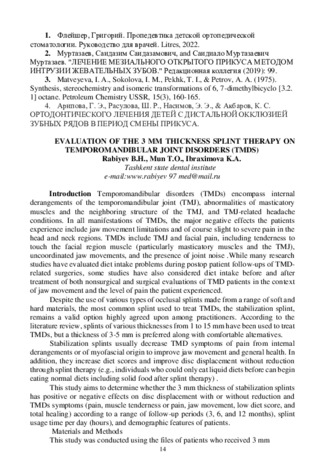
14
1.
Флейшер, Григорий. Пропедевтика детской ортопедической
стоматологии. Руководство для врачей. Litres, 2022.
2.
Муртазаев, Саидазим Саидазамович, and Саидиало Муртазаевич
Муртазаев. "ЛЕЧЕНИЕ МЕЗИАЛЬНОГО ОТКРЫТОГО ПРИКУСА МЕТОДОМ
ИНТРУЗИИ ЖЕВАТЕЛЬНЫХ ЗУБОВ." Редакционная коллегия (2019): 99.
3.
Matveyeva, I. A., Sokolova, I. M., Pekhk, T. I., & Petrov, A. A. (1975).
Synthesis, stereochemistry and isomeric transformations of 6, 7-dimethylbicyclo [3.2.
1] octane. Petroleum Chemistry USSR, 15(3), 160-165.
4.
Арипова, Г. Э., Расулова, Ш. Р., Насимов, Э. Э., & Акбаров, К. С.
ОРТОДОНТИЧЕСКОГО ЛЕЧЕНИЯ ДЕТЕЙ С ДИСТАЛЬНОЙ ОККЛЮЗИЕЙ
ЗУБНЫХ РЯДОВ В ПЕРИОД СМЕНЫ ПРИКУСА.
EVALUATION OF THE 3 MM THICKNESS SPLINT THERAPY ON
TEMPOROMANDIBULAR JOINT DISORDERS (TMDS)
Rabiyev B.H., Mun T.O., Ibraximova K.A.
Tashkent state dental institute
e-mail:www.rabiyev 97 med@mail.ru
Introduction
Temporomandibular disorders (TMDs) encompass internal
derangements of the temporomandibular joint (TMJ), abnormalities of masticatory
muscles and the neighboring structure of the TMJ, and TMJ-related headache
conditions. In all manifestations of TMDs, the major negative effects the patients
experience include jaw movement limitations and of course slight to severe pain in the
head and neck regions. TMDs include TMJ and facial pain, including tenderness to
touch the facial region muscle (particularly masticatory muscles and the TMJ),
uncoordinated jaw movements, and the presence of joint noise .While many research
studies have evaluated diet intake problems during postop patient follow-ups of TMD-
related surgeries, some studies have also considered diet intake before and after
treatment of both nonsurgical and surgical evaluations of TMD patients in the context
of jaw movement and the level of pain the patient experienced.
Despite the use of various types of occlusal splints made from a range of soft and
hard materials, the most common splint used to treat TMDs, the stabilization splint,
remains a valid option highly agreed upon among practitioners. According to the
literature review, splints of various thicknesses from 1 to 15 mm have been used to treat
TMDs, but a thickness of 3-5 mm is preferred along with comfortable alternatives.
Stabilization splints usually decrease TMD symptoms of pain from internal
derangements or of myofascial origin to improve jaw movement and general health. In
addition, they increase diet scores and improve disc displacement without reduction
through splint therapy (e.g., individuals who could only eat liquid diets before can begin
eating normal diets including solid food after splint therapy) .
This study aims to determine whether the 3 mm thickness of stabilization splints
has positive or negative effects on disc displacement with or without reduction and
TMDs symptoms (pain, muscle tenderness or pain, jaw movement, low diet score, and
total healing) according to a range of follow-up periods (3, 6, and 12 months), splint
usage time per day (hours), and demographic features of patients.
Materials and Methods
This study was conducted using the files of patients who received 3 mm

15
stabilization splint therapy as a conservative or initial treatment of TMDs. The
patients’ files were from 2020 to 2021. TMDs were diagnosed in the same clinic
according to the clinical and radiological data. Magnetic resonance imaging, the most
accurate radiological tool, was used for diagnosis before initial treatments, and
examinations were done based on Diagnostic Criteria for Temporomandibular
Disorders (DC/TMD) axis I which is the main guide for evaluating patients to
determine final diagnosis and treatment progress for TMDs. In the same clinic,
informed consent was obtained from patients before beginning treatments, in which
they consented to the use of their diagnosis and treatments as scientific data.
Conclusion
Conclusions drawn from our retrospective research on the effects of 3 mm thick
stabilization splints on TMD signs and symptoms are as follows:(1)There were no
remarkable effects of splints on total TMD healing in the first 3-month period with a
success rate of only 44% (11 patients). There was also no significant difference between
3 months and 6 months (12 patients, 48%).(2)There was no correlation between daily
splint usage duration and total healing of TMD signs and symptoms.(3)Researching
diet score parameters differentiates our study from other studies on TMDs. In addition,
high diet scores were achieved using 3 mm splint therapy.(4)Despite achieving low
success rates in early (3 months) and midterm (6 months) treatment periods, by the end
of splint therapy (12 months), a success rate of 88% was achieved for 3 mm splint
therapy on all symptoms of TMDs, which we consider a successful outcome for a
conservative and reversible treatment option.
Finally, TMD signs and symptoms should include TMD pain, amount of mouth
opening, and diet score, which encompass our definition of “total healing” of TMDs in
our study
References
1.
Конференция,
VIIЕМ.
"СПУТНИКОВЫЙ
ФОРУМ
ПО
ОБЩЕСТВЕННОМУ ЗДОРОВЬЮ И ПОЛИТИКЕ ЗДРАВООХРАНЕНИЯ."
(2018).
2.
Lukovskaya, E. V., Bobyleva, A. A., Pekhk, T. I., Dubitskaya, N. F.,
Petrushenkova, I. A., & Belikova, N. A. (1988). Interaction of cis-bicyclo (4.3. 0) nona-
3, 7-diene with iodine. Synthesis of tricyclo (4.3. 0.0 3, 7) nona-4, 8-diene (brexa-4, 8-
diene). Zhurnal Organicheskoj Khimii, 24(7), 1457-1463.
3.
Нигматов, Р. Н., and И. М. Рузметова. "Способ дистализации
жевательных зубов верхней челюсти." Вестник Казахского национального
медицинского университета 1 (2018): 519-521.
4.
Арипова, Г. Э., Расулова, Ш. Р., Насимов, Э. Э., & Акбаров, К. С.
ОРТОДОНТИЧЕСКОГО ЛЕЧЕНИЯ ДЕТЕЙ С ДИСТАЛЬНОЙ ОККЛЮЗИЕЙ
ЗУБНЫХ РЯДОВ В ПЕРИОД СМЕНЫ ПРИКУСА.
5.
АРИПОВА,
ГАВХАР
ЭРКИНОВНА,
and
ШАХНОЗА
РАСУЛЖАНОВНА РАСУЛОВА. "ПОДХОД К ЛЕЧЕНИЮ ПАЦИЕНТОВ С
ДИСТАЛЬНЫМ ПРИКУСОМ С УЧЁТОМ ТИПА РОСТА ЧЕЛЮСТНЫХ
КОСТЕЙ." МОЛОДЕЖНЫЙ ИННОВАЦИОННЫЙ ВЕСТНИК Учредители:
Воронежский государственный медицинский университет имени НН
Бурденко 11.S1 (2022): 414-415.






